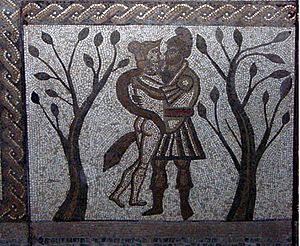Low Ham Roman Villa facts for kids
The Low Ham Roman Villa was a large Roman country house. It was found near Low Ham in Somerset, England. This villa is famous for its amazing mosaic floor. The mosaic shows a story about Aeneas and Dido.
This old site is now a protected historical place. It is also on the Heritage at Risk Register. This means it needs special care. Animal burrows are causing some damage to the site.
Finding the Villa
A local farmer named Herbert Cook found the villa in 1938. He was digging a hole to bury a sheep when he made the discovery. The site was safe from deep farm work during World War II.
Later, from 1946 to 1955, experts studied the villa. H S L Dewar and C A Ralegh Radford led these digs. They carefully uncovered parts of the old Roman building.
The Roman Villa
The Low Ham Roman Villa was likely built around the year 340 AD. It stood on a gentle slope facing the northeast. Other Roman villas were also found nearby. These include villas at High Ham and Pitney.
Pictures taken from the air show many farm buildings. These buildings were set around a large courtyard. The excavations mostly focused on the main living area. This was the west wing and the bathhouse.
The bathhouse was very impressive. It had all the usual rooms for bathing. There was a deep cold pool. A beautiful mosaic floor led the way to this pool.
The Amazing Mosaic Floor
The most famous part of the villa is its large mosaic floor. It is about 14 feet (4.3 meters) square. This mosaic was in the frigidarium, which was the cold room of the bathhouse.
The mosaic tells a story from the Roman poet Virgil. It shows scenes from the tale of Aeneas and Dido. Like the villa itself, the mosaic is from the mid-4th century.
The Low Ham mosaic is special because it tells a story in five parts. No other Roman mosaic in Britain does this.
- The first scene shows Aeneas sailing to Carthage. His friend Achates takes a crown from the ship. This crown was a gift for Dido.
- Next, Aeneas meets Dido. His son Ascanius and his mother Venus are also there.
- Then, you can see the couple out hunting together.
- Another part shows Aeneas and Dido embracing.
- The last scene might show Venus. Or it could be Dido left alone after Aeneas leaves.
This mosaic is the earliest piece of story-telling art found in Britain. It was carefully removed in 1953. Today, you can see it on display at the Museum of Somerset.


